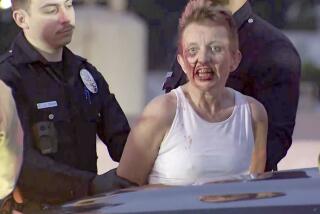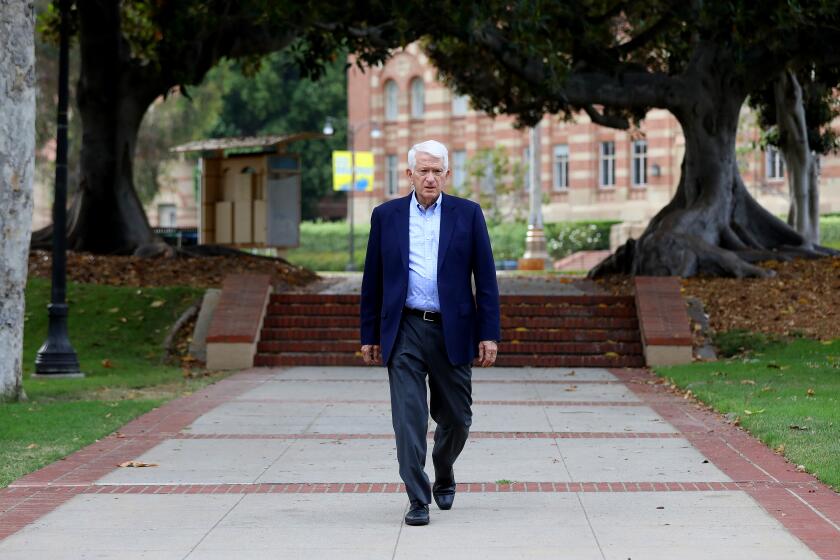Visitors Bureau Spent Lavishly
The Los Angeles Convention & Visitors Bureau has spent nearly $3 million a year on travel, food and entertainment in its quest to promote the city, once renting a hall in England’s Kensington Palace to woo airline executives and spending $84,000 to entertain travel agents and others at the Wimbledon tennis tournament, documents show.
The bureau, which is largely funded by the city, also spent $835,000 on a gala dinner for travel agents in Glasgow, Scotland, where Natalie Cole and her orchestra played for 3,000 VIPs, according to bureau records released Friday.
For the record:
12:00 a.m. July 25, 2002 For The Record
Los Angeles Times Thursday July 25, 2002 Home Edition Main News Part A Page 2 National Desk 15 inches; 537 words Type of Material: Correction
Convention Center--An article in the May 25 California section on the Los Angeles Convention and Visitors Bureau’s work to increase tourism mistakenly reported that visitors from the seven countries that send the most tourists to Los Angeles generated $1.8 million in spending in 2002. The correct number is $1.8 billion.
*
The documents show city officials and bureau members travel in high style, staying in expensive hotels and dining in trendy restaurants. For the Wimbledon event, for example, one bureau delegate stayed five nights in an $854-per-night suite at London’s Four Seasons hotel, paid for by the bureau.
The records sparked criticism from some city officials and taxpayer advocates, who said they viewed the spending as lavish.
“Even by Los Angeles standards this is an absolute outrage,” said Jon Coupal, president of the Howard Jarvis Taxpayers Assn. “At a time when the city is claiming poverty, to waste money in this way--heads should roll.”
Councilman Jack Weiss, vice chair of the City Council Budget Committee, said he found the expenses “troubling,” because the city gave the bureau about $18 million in hotel bed taxes to promote tourism and line up conventions.
“Expenditures such as these justifiably cause taxpayers to be skeptical,” Weiss said.
The nonprofit agency released heavily edited expense documents for specific trips three weeks after The Times requested the papers. They covered a three-year period beginning in 1997.
Other city records indicate the bureau has spent about $2.9 million a year on travel for its people and clients during the same period.
The same day the bureau released its documents, it also announced it was taking steps to adopt reforms, including changes in spending policies for trade missions and the bureau’s bonus and compensation practices.
Bureau President George Kirkland and Alan Rothenberg, chairman of the bureau’s Board of Directors, were out of town and not available for interviews Friday, a spokesman said. They left behind statements indicating the goal of the reforms will be to improve the bureau’s performance at attracting conventions and tourists.
In a recent interview Rothenberg defended Kirkland.
“He does what he thinks will bring business to Los Angeles and he does it well,” Rothenberg said. “I’ve found unless you have a monopoly, you have to spend money to make money.”
In the 1999-2000 fiscal year, the last year for which bureau budget records were available, the agency received $17.5 million from the city in hotel bed taxes. The remainder of the bureau’s $27.9-million budget comes mainly from membership dues.
That year, the bureau reported to the city that it spent $1.39 million in staff travel expenses, of which $1.1 million came from city taxes. The travel expenses cover domestic and international sales trips.
Also that year, the bureau spent $2.1 million on client accommodations, entertainment and travel. Records show bureau officials favor restaurants owned by Wolfgang Puck and four-star hotels. The bureau also racked up a limousine service bill of $507,000.
More than $700,000 was spent that year on food and beverages. Expenses were similar for the other years.
The 2000 trade mission to England, which featured attendance at the Wimbledon championships, was one of the most expensive mounted by the bureau in recent years.
The city delegation was led by bureau President Kirkland and included city Airport Commission President John Agoglia, Airport Department assistant administrator Phil Depoian, city Chief Legislative Analyst Ron Deaton, two bureau board members and three other bureau officials.
The city Airport Department, which pays the bureau $3 million a year to promote city airports, paid $7,400 for each round-trip business-class ticket to London used by Deaton, Agoglia and Depoian.
Kirkland and other bureau officials received complimentary tickets from the airlines that are members of the bureau. Officials would not disclose the value of the tickets.
Kirkland, Agoglia, Deaton and the board members brought their wives, but they were responsible for their own airfares.
Hotel lodgings ranged from $419 to $854 per night, with the latter a suite that also included space for entertaining and conducting interviews. The hotel bills were paid by the bureau from its membership dues.
The bureau declined to identify who stayed in the suite and other rooms.
Expensive hotel bookings are not unusual. Bureau delegates on a trip to Germany the year before spent up to $616 per room per night.
After a day of meetings with travel magazine and newspaper writers and briefings in England, the city and bureau officials and their wives went to Kensington Palace, where the British royal family still maintains apartments.
The bureau spent $11,600 to rent a hall and provide a dinner for the city delegation and select airline executives.
The event was held “to promote LAX and the potential of Ontario International Airport as an emerging passenger and cargo gateway,” bureau records indicate.
On the third day of the trip, the bureau spent $84,000 in city tax funds to host 25 English tour operators, as well as the Los Angeles delegation, for a day at the Wimbledon tennis championships.
In addition to attending a center court match, the group went to a bureau prematch reception and then to an after-match tea.
The event was held to “strengthen L.A.’s visibility,” bureau officials said, adding afterward that Los Angeles was included in 15% more tour operator brochures.
Councilman Weiss said he wanted to see the proof that the tennis match was a worthwhile taxpayer expense.
“If there is a logic to showing someone a good time at a fancy foreign location in a way that helps promote dollars on the ground in Los Angeles, somebody please explain it to me,” he said.
Although the Wimbledon and Kensington Palace events were costly, their expense was a fraction of the $835,000 spent by the bureau in 1997 to fete 3,000 members of the American Society of Travel Agents in Glasgow. City taxes provided $186,000 of the cost of the event.
Kirkland said in a statement that reforms will call for “creating policy guidelines with respect to trade missions.”
The 10 foreign sales missions held in the last three years are an important part of boosting tourism in Los Angeles, the bureau statement said.
Los Angeles’ top seven markets, including Mexico, Japan and Britain, generated 3.7 million international visitors in 2000 and nearly $1.8 million in spending, according to the bureau.
However, Lesa Slaughter, a member of the city Convention Center Commission, said the bureau’s spending is hard to justify when its performance is as poor as it has been.
In the last three years, 42 major conventions have canceled in Los Angeles, the most scratches the bureau has experienced, officials said. As a result, the Convention Center is operating at just 72% capacity. The Times reported April 29 that the bureau had paid $225,000 in bonuses to its sales staff and executives for booking events at the city-owned Convention Center even though 20 of the events cited to justify the payments were later canceled.
The bureau also has missed goals for boosting tourism to Los Angeles in two of the last three years, records show.
“They have a perception problem regarding the spending and they don’t have the performance to back it up,” Slaughter said. “What it raises is who is watching the cash register.”
More to Read
Start your day right
Sign up for Essential California for news, features and recommendations from the L.A. Times and beyond in your inbox six days a week.
You may occasionally receive promotional content from the Los Angeles Times.







